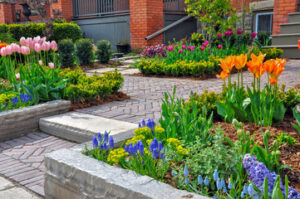Sacramento Cabinet Refacing involves changing the visible parts of your cabinets, including the doors and drawer fronts. The process replaces the old surface materials with durable 3D laminate.
Refacing is ideal if your cabinet surfaces have become worn or stained. It is also a good choice if you want a new kitchen look but do not need or desire to change your cabinet layout.

Less Mess
Many homeowners are familiar with the option of replacing their cabinets, but refacing is often a more affordable and more efficient solution. This is because refacing allows you to update your kitchen without making any major changes to its layout. Instead, refacing your cabinets will change the overall look of your kitchen by adding new cabinet doors and drawer fronts that are finished in a style and color of your choice.
The cabinet refacing process begins by removing the existing cabinet doors, drawer fronts, and hardware. This allows the installer to work with a clean slate and ensures a high-quality finish. The existing cabinet framework is then cleaned, sanded, and repaired as needed to create a solid base for the new veneer or laminate. Once the cabinet frame is ready, the new cabinet door and drawer fronts are installed. Finally, updated handles, knobs, and hinges are applied to complete the new look.
Refacing also eliminates the need to stain your cabinets, which is an involved and labor-intensive process that can be difficult for inexperienced DIYers to get right. This is because staining requires stripping the existing finish from the cabinetry, which may require chemical paint or stain remover. By avoiding the need to stain, cabinet refacing is typically completed within a shorter timeframe than an entire kitchen remodel and can be done with less mess.
Choosing the right contractor for your cabinet refacing project is critical for ensuring the quality of the results. An experienced contractor will be able to provide you with an accurate estimate for the project and will have the knowledge, skills, and tools to transform your outdated kitchen into a modern space.
While cabinet refacing offers a great option for updating your kitchen’s appearance, it is important to keep in mind that this is not a solution for every scenario. If you have older, dated cabinetry with significant water damage, full replacement may be the better choice. In addition, if the cabinet boxes are warped or rotting, this can create structural issues that would not be resolved by refacing alone.
Less Waste
When you choose cabinet refacing instead of replacing your cabinets, you reduce the demand for new raw materials. This helps conserve natural resources like wood and reduces the environmental impact associated with the extraction and production of these materials. Since refacing utilizes existing cabinet structures, it also keeps usable materials out of landfills.
Unlike traditional replacement, cabinet refacing utilizes your existing cabinet boxes and simply adds new veneer surfaces and hardware. The result is a modern, updated look without discarding the original cabinet structures. Refacing also extends the life of these cabinets and diverts usable materials from landfills, reducing overall waste.
Home renovations generate a significant amount of waste material. Refacing a cabinet significantly reduces this waste, conserving valuable landfill space and reducing the need for future renovations. It’s important to work with a qualified remodeling company that recycles as much material as possible. Look for companies that use eco-friendly materials, such as thermofoil, which uses recyclable PVC to create a durable surface with a beautiful finish.
When refacing a cabinet, you can choose from a wide variety of door styles and materials to make your kitchen more customized. You can even select from a range of hardware options, such as modern metals like nickel or classic choices like brass. By selecting the right materials, you can ensure your remodel is as environmentally friendly as possible while achieving your ideal kitchen design.
Another way to minimize your environmental impact is by choosing cabinet doors and drawer fronts made from reclaimed wood, which contributes to sustainable forest management and helps preserve biodiversity. When purchasing reclaimed wood, be sure to look for certifications like the Forest Stewardship Council label that indicate responsible harvesting practices.
Finally, by using low-VOC paints and finishes, you can help minimize indoor air pollution during the remodeling process and into the future. This will help improve indoor air quality and make your home healthier for your family to live in. By choosing energy-efficient cabinet doors and drawer fronts, you can optimize temperature regulation in your home and save on your heating and cooling costs.
Quicker Turnaround
In contrast to a full kitchen remodel, cabinet refacing typically involves minimal construction, allowing you to enjoy the results of your kitchen upgrade in a shorter time frame. The refacing process requires the removal of existing doors, drawer fronts, and hardware, but it isn’t a complete demolition. The original cabinet boxes are cleaned, sanded, and prepped before applying high-quality veneer or laminate to the visible surfaces of the cabinet frames. New cabinet doors and drawer fronts are then installed, along with updated hardware. A fresh, clean aesthetic and improved functionality result in a transformed kitchen in as little as three days.
Cabinet refacing allows for endless design options that can accommodate any aesthetic. From a rustic farmhouse style with distressed finishes and decorative hardware to a sleek and minimalist vibe with handleless designs, refacing provides the freedom to explore your preferences. It also means that you can achieve the updated look you want without compromising on budget.
Moreover, cabinet refacing is a greener alternative to a total replacement because the original cabinets aren’t destroyed or discarded. The use of wood veneers for the cabinet doors further reduces environmental impact, as these materials come from sustainable forests that are managed responsibly.
Refacing can also help boost your home’s value. Since buyers focus on the kitchen, a new cabinet appearance is an easy way to make a big impact that can quickly pay for itself. A fresh and appealing kitchen is also more functional, which is a huge selling point for any prospective buyer. In fact, minor kitchen upgrades like refacing can increase your home’s value by up to 96%, according to one study.
Better Appearance
Cabinet refacing offers the same aesthetic changes as a complete kitchen remodel without the higher costs and longer timeframe. Whether your cabinets are dated, damaged or worn, the new doors and drawer surfaces can transform your home’s overall appearance for an appealing finish that elevates your kitchen’s style. The wide range of design options empowers homeowners to create a cohesive look that matches their tastes and style preferences.
A cabinet refacing process is also more eco-friendly than a full replacement, avoiding the production of unused material that ends up in landfills. It also reduces waste and resource consumption, especially when paired with low-VOC paints or eco-conscious wood products.
However, keep in mind that refacing doesn’t address structural issues or improve storage efficiency. If your cabinets are old or worn out, replacing them is the best option to ensure durability and avoid future problems like warping, fading or mold growth.
Refacing is an ideal solution for a home that’s ready for a full overhaul but may not be able to afford the expense of a kitchen renovation. In fact, it’s typically cheaper than a complete remodel and pays for itself in increased home value. It also saves time because there is no construction and less mess to clean up, allowing homeowners to enjoy their newly transformed kitchen in just a few days.
A professional cabinet refacing service will use high-quality materials that are resistant to moisture, scratches and stains to ensure a long lifespan for your new cabinets. The materials will also withstand heavy foot traffic and everyday use. This is not the case with many low-cost refacing services that use laminates, which can easily develop delamination and don’t last as long.
Although refacing is less expensive than a full replacement, it’s important to remember that the process does not resolve any structural issues or improve storage efficiency. It also doesn’t address any underlying wear and tear, making it important to keep an eye out for damage and additional repairs over the years. However, it’s worth the investment because a fresh new look can add value to your home and increase its resale potential.








